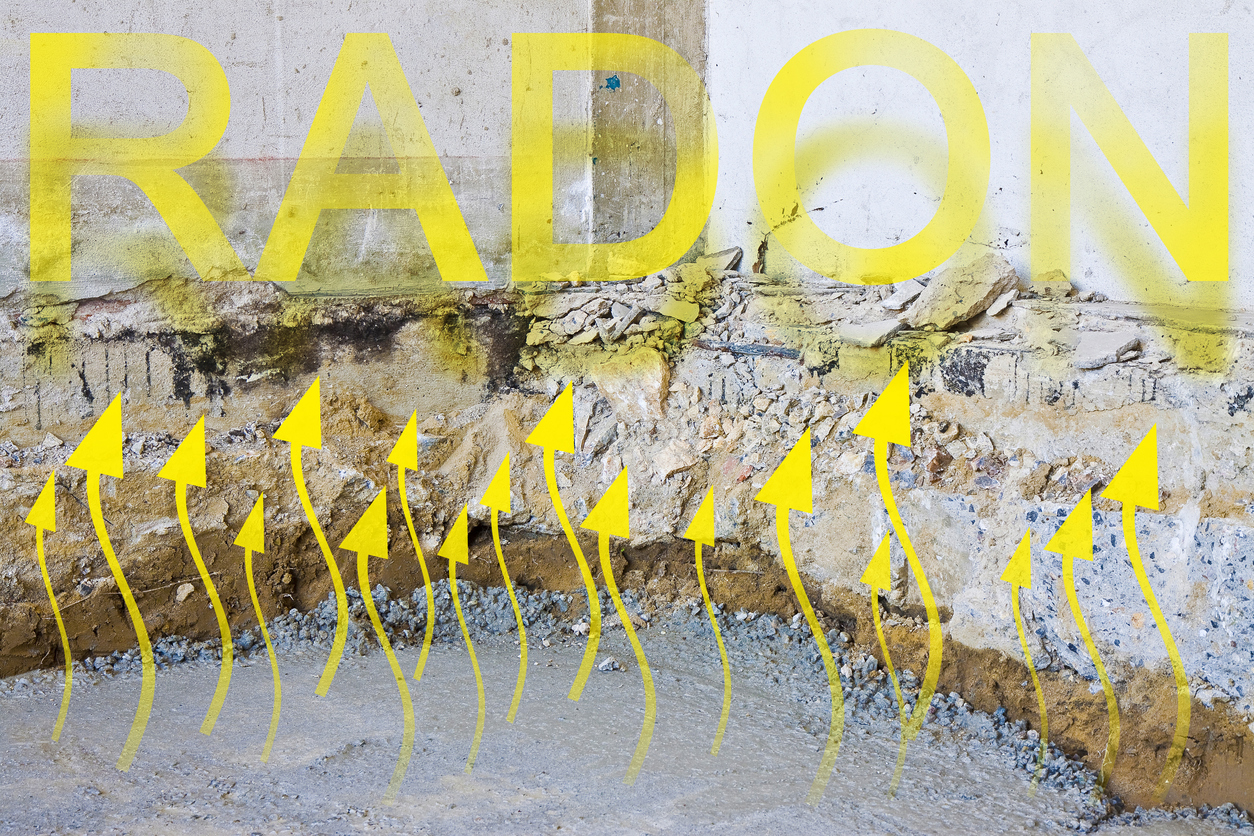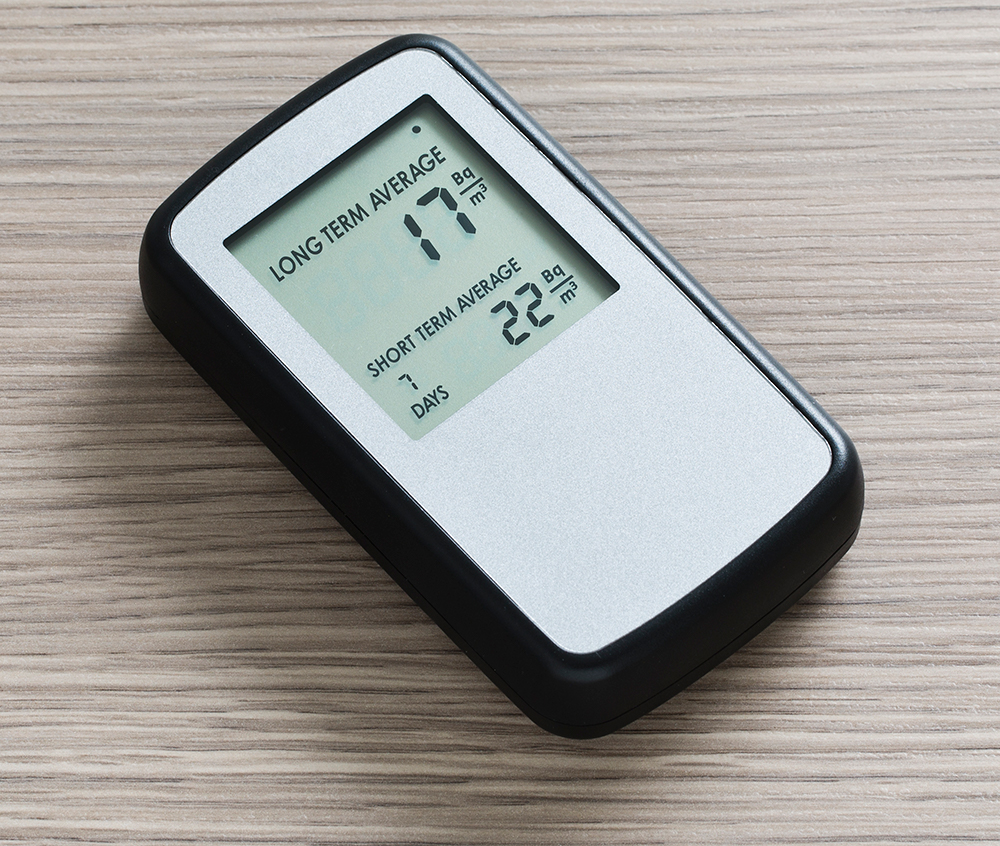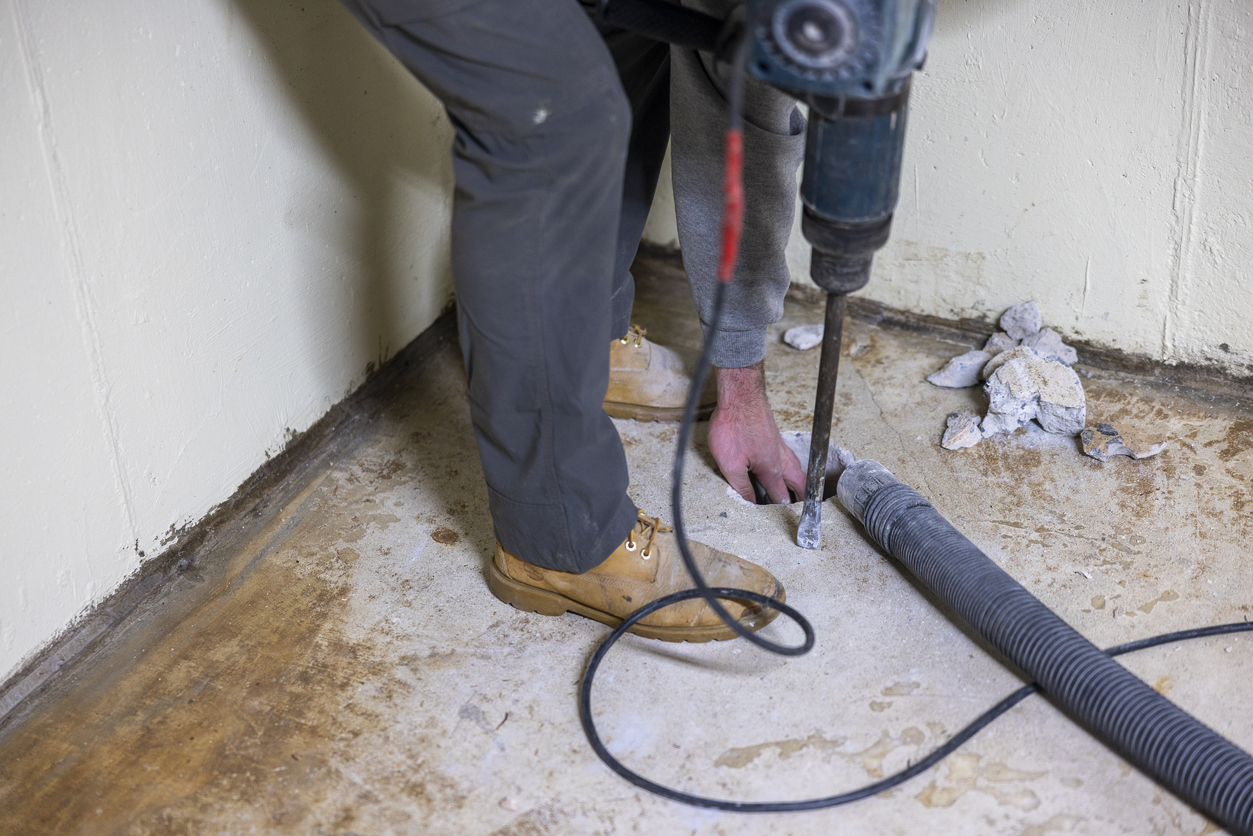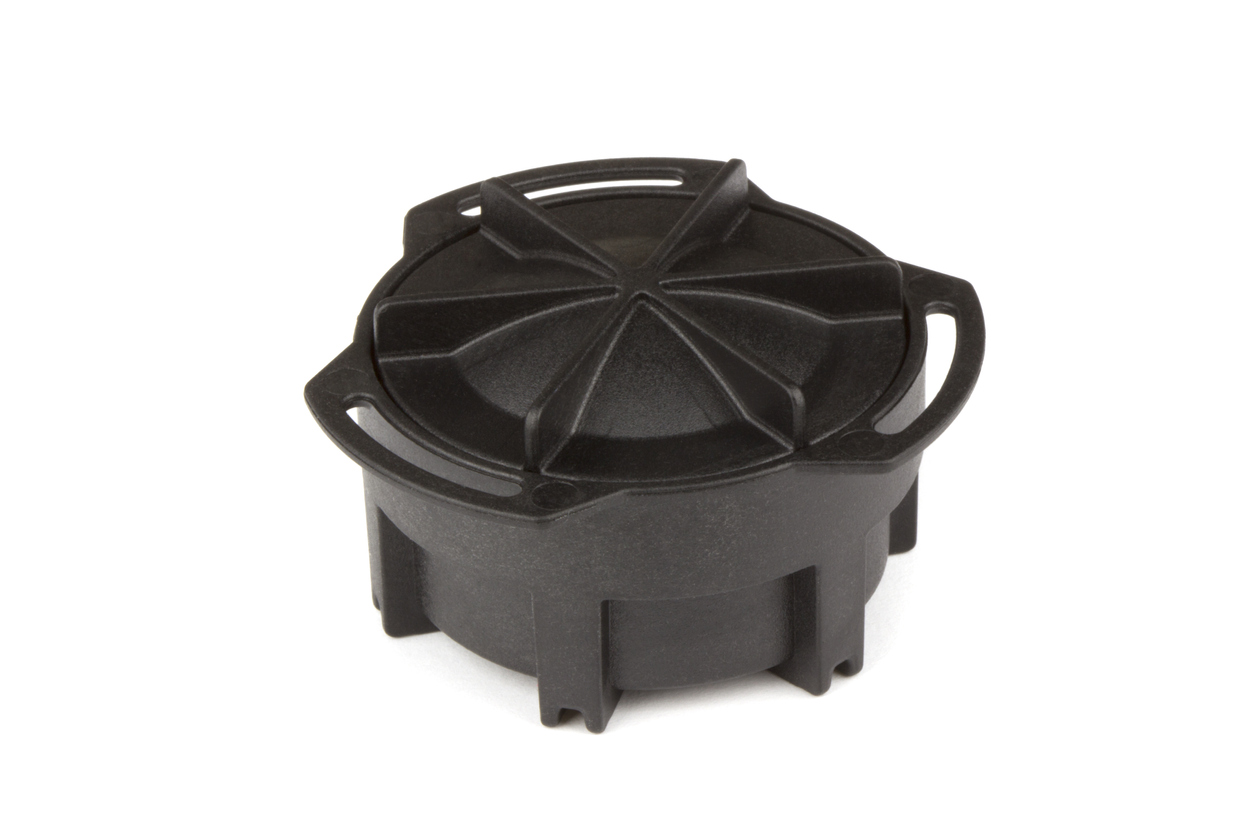

We may earn revenue from the products available on this page and participate in affiliate programs. Learn More ›
Purchasing a new home can be as stressful as it is exciting. While most buyers seek out homes that suit their budgets and lifestyles, the homes also need to be in good structural condition and harbor no hazards—such as high levels of radon gas.
Radon gas naturally seeps into a home through gaps in the home’s exterior, like those in the foundation. As the gas decays, radioactive particles are released into the air. Even though you can’t see it, smell it, or taste it, radon gas is a leading cause of lung cancer, according to the National Cancer Institute. Yet the presence of radon in homes need not be a deal breaker. Potential homebuyers may think, why not?
“Radon can be found in homes of any size, age, or area, although high concentrations of radon are known to be found in the Northeast and upper Midwest,” says Josh Rogers, a training specialist at Seattle-based WIN Home Inspection.
In fact, according to the Iowa Department of Health & Human Services, the Hawkeye State has the largest percentage (71.6 percent) of homes above 4 pCi/L, the level at which the U.S. Environmental Protection Agency (EPA) recommends mitigation.
“If you are in the market to purchase a new home,” Rogers says, “should a high concentration of radon be found in the home, there are steps homebuyers and sellers can take to mitigate it.”
If a home you’re buying or selling has elevated levels of radon, it’s certainly a concern—but it’s not necessarily a dealbreaker. Here’s what to know about the dangers of radon, how to have a property tested for radon, and what can be done when high levels of the gas are detected on a property.
What is radon gas?

Radon gas is a byproduct of the underground decay of radioactive elements, such as uranium and thorium. As these substances deteriorate, the gas is released and eventually works its way to the surface of the ground and into the air we breathe.
Fortunately, radon gas is so diluted in our outdoor environment that it doesn’t pose a health risk. Inside buildings, however, it can become concentrated. Every state in the U.S. has radon gas, but some areas are at higher risk than others. This interactive radon zone map will help you determine whether you are house hunting in a high-risk zone.
Why should I be concerned about radon?
While radon is considered harmless in the low levels that are found outdoors, the gas becomes more concentrated when it seeps indoors. Because radon seeps through soil and rocks in the ground, the highest concentrations of the gas are most likely found in the basement or ground floor of a dwelling. Radon gas is measured in picocuries per liter (pCi/L); the EPA recommends radon mitigation for all homes with radon gas levels of 4 pCi/L or higher.
Radon gas is slightly heavier than air, so while it settles in basements and crawl spaces, whole-house HVAC systems have a tendency to distribute the gas throughout the home. For this reason, upper floors of a home could also contain high concentrations of radon.
According to the National Cancer Institute (NCI), airborne radon particles are radioactive and, when inhaled, can damage the lining of the lungs. Radon may also contribute to leukemia, although more studies are needed to verify a definitive link. Living in a home with high radon levels increases the risk of developing lung cancer. The higher the gas concentration, the more likely those living in the house will develop cancer at some point in their lives.
The risk of developing radon-related lung cancer also increases substantially if the home’s inhabitants are smokers. The EPA estimates reveal the correlation between a home’s radon level and the risk of smokers who live there developing radon-related cancer. For example:
- Of 1,000 smokers living in a house with a 1.3 pCi/L concentration of radon gas, approximately 20 could develop lung cancer.
- As many as 62 of 1,000 smokers could develop lung cancer if they lived in a home with a 4 pCi/L radon gas level.
- Approximately 150 smokers who live in a home with radon gas levels at 10 pCi/L could develop lung cancer. That rate is about 200 times the risk of dying in a house fire.
Are there safe radon levels in a home?
While there are no absolutely safe radon levels, the EPA strongly recommends taking steps to reduce indoor radon levels if they occur in concentrations higher than 4 pCi/L. However, because radon gas at any level indoors poses a risk, the agency also suggests treating homes with radon levels between 2 and 4 pCi/L. According to the EPA, the average radon gas concentration in a home is about 1.3 pCi/L, which does not pose an appreciable risk to most people. Outdoor radon gas levels are typically just 0.4 pCi/L, a minuscule level that isn’t considered a health risk.
Will a radon disclosure protect me if I’m selling my home?
As a part of the home selling process, homeowners fill out a disclosure form that lists known material defects, such as foundation problems, termite infestation, and the condition of the HVAC system. However, what sellers must disclose varies from state to state, and not all states require sellers to reveal the home’s radon status.
If your state doesn’t require radon gas disclosure (Zillow’s list of states’ disclosure requirements may come in handy), you still have the right to request a radon test before buying a house.

How do I get a radon test?
When making an offer on a house, buyers have the opportunity to request an inspection and various tests, including one for radon. A mortgage lender will often require structural and mechanical inspections to ensure the loan is a wise financial investment, but a lender does not always require radon testing. You may specifically have to ask for a radon test, and pay for it yourself.
A professional radon test typically costs less than $200. According to the EPA, all houses should be tested for radon by a local mitigation contractor. Even if you’re staying put in your house, it’s worthwhile have an idea of what your indoor radon levels are. Radon test kits typically cost less than $30, including the lab’s fee to process the results; many home air quality monitors assess radon levels along with volatile organic compound (VOC) levels, humidity, and temperature.
RELATED: How to Test for Radon in Your Home
What does a radon test involve?
A radon professional is a technician equipped with a radon sniffer, a tool that detects the presence and concentration of radon in homes. Since radon is heavier than air, the technician may ask the homeowner to turn off the HVAC system an hour or two prior to testing, allowing any gas in the house to settle near the floor.
The technician will also leave charcoal-filled canisters in different areas of the house for several days; the canisters will then be retrieved and analyzed for the presence of radon. Though DIY, mail-in radon tests are cheaper than a professional assessment, professional testing results are usually only considered for the purposes of .

How does radon mitigation work?
If a radon test indicates that a home has high of gas, the EPA suggests having a professional radon mitigation contractor remedy the problem. Homeowners should first check with their State Radon Office to determine which certifications are necessary for radon mitigation work in their area.
The purpose of radon gas removal is to reduce the level of the gas, not to eliminate it, since radon gas is not considered a significant risk in levels lower than 4 pCi/L. Radon reduction seeks to prevent radon from entering a house—and remove existing radon from the home.
Mitigation is “a fairly simple fix,” Rogers says, one in which radon professionals “basically core a hole in the foundation and install a fan and a pipe that terminates above the roofline. This puts negative pressure on the foundation and the radon gas safely exits the home. Not a lot of parts involved and really the only wear item is the fan, which can be repaired or replaced very easily. They also use a liquid (kind of like a level) that shows the homeowner that the mitigation system is pressurized and working as needed.”
Not all states regulate radon mitigation contractors or their services. If you live in a state without regulations, the EPA recommends ask your contractor about their experience with radon mitigation, and whether they are radon certified by the American Society for Testing and Materials (ASTM) or have other similar credentials.
How can I keep radon from entering my home?

Preventing radon from entering involves sealing the areas where it can seep in, such as cracks in basement floors and walls, as well as gaps around service pipes. In some cases, it may also require installing a radon pipe under the basement to transfer radon gas away from the house. Removing existing radon involves the installation of ventilation fans to circulate radon-heavy basement air to the outdoors.
What happens if a test reveals that our home has radon?
Depending on how your home’s sales or purchase contract is worded, both buyer and seller may share the cost of mitigating the radon.
“Should the test results reveal radon levels exceeding acceptable thresholds,” says Brett Johnson, a seasoned investor and owner of Denver-based home buying company Cash For House Pro, “Buyers frequently request sellers to either install the mitigation system before the closing or negotiate for a credit to address the issue.”
If the contract doesn’t specify who pays for mitigation, you can certainly ask the sellers to split the cost—and they may be willing to do so to help the sale go through. The cost of installing a professional radon mitigation system runs $771 to $1,185, with an average bill of about $978. Systems in larger homes (or those with complicated layouts) can cost a few thousand dollars.
Should I buy a house that tests positive for radon?
As the EPA puts it, “Radon is a health hazard with a simple solution.” Once radon reduction measures are in place, home buyers need not worry about the quality of the air in the home. If a house you’re interested in has high levels of radon, odds are, other houses in the area are likely to have high levels as well.
Since removing radon is relatively simple, your family can be safe in a home that has a radon reduction system in place.
Should I buy a house with a radon mitigation system?
When considering the purchase of a house with a radon mitigation system, it’s important to weigh the benefits against potential costs. While a mitigation system can enhance the indoor air quality of a house impacted by radon, buyers should consult with their realtor to assess the effectiveness and maintenance of the system.
“Radon levels can fluctuate throughout the year due to factors like weather, ventilation, and soil conditions,” says Ritika Asrani, owner and head broker of St Maarten Real Estate in St Maarten. “When negotiating on a property with elevated radon levels, it’s essential to consider conducting multiple radon tests over time. This can provide a more accurate representation of the radon risk and help in price negotiations.”
Are there future radon risks to consider?
Even if a professional radon test reveals that a home’s levels are relatively safe, these levels can change over time. If the house settles, for example, a tiny foundation crack could allow the gas to seep in. Radon levels can also fluctuate seasonally (winter levels are usually higher because we have our homes sealed tight against the cold). For these reasons, it’s a good idea to install one or more radon detectors, such as the Airthings Corentium Home Radon Detector, on the lower floors of your home. These detectors will alert you if radon levels rise, at which point you can take steps to mitigate the problem.
What to Do if You Think You’ve Been Exposed to Radon

If you think you’re experiencing symptoms of radon exposure, it’s a good idea to talk to your doctor. While most people who are exposed to radon gas won’t develop lung cancer, the doctor can at least make a note of the exposure and take proactive measures.
- If the doctor feels it’s necessary, lung cancer screening, such as a low-dose CT scan, can be used to determine the presence of lung cancer.
- The risk of developing radon-related lung cancer is lower if radon levels in the home are lowered.
- Smokers who have been exposed to radon can reduce their risk of developing lung cancer by stopping smoking.
Final Thoughts
Radon is a natural gas, and it’s found virtually everywhere. However, it is only considered dangerous in high concentrations. Fortunately, radon mitigation is a relatively straightforward process of diverting the gas away from a home’s foundation, and radon mitigation costs are only about $1,000, depending on the size of the house and local labor prices. In the end, it’s a small price to pay to lower your risk of developing cancer.
FAQs
Radon is commonly found in homes worldwide. It can be found in homes of any age or location. It’s estimated that one of every 15 homes in the United States has high radon levels.
A radon test can take anywhere from 2 days to a few months, depending on the type of test and scope of the project.
Radon tests should be placed in the lowest livable part of a home, like a finished basement or ground floor. It should be situated away from drafts, high humidity, and direct sunlight.
